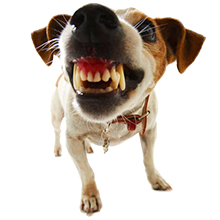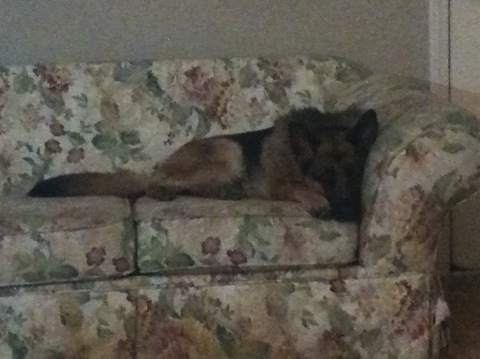Blue Ribbon K9 - Las Vegas Dog Training
The Humane Dog Trainers Of Las Vegas
Barking Dogs... what to do!
First pick a word to use like no bark or quiet, then get yourself a short training line and when the dog starts to bark tell him, “no bark, quiet,” then give him a slight correction. You will probably need to do this several times.
If this method still is not producing good results you can always us a water bottle or canned air also say quiet and spray him. In the old days we use to use a hose.
For really stubborn dogs you will need to increase the firmness of your correction and be consistent. All dogs will finally give up, we just need to be firm and consistent with our corrections.
In extreme cases you can us a nylon muzzle but make sure the dog can pant easily and put it on him for 15 minutes then take it off, also with very stubborn dogs you might want to go to a bark collar. I would use this as a last resort. If this is the case consult a professional trainer before trying this method, so they can show you how to use it properly.
Call us will all your dog training question: 702-656-9719
Should I let my dog sleep on my bed?
Another point when your dog sleeps on the bed with you he brings little treasures that he has acquired during the day onto your bed. This is another critical issue. There are all sorts of diseases and parasites that you can catch from sleeping with your dog. Their system is designed to better handle these different bacterias and parasites and yours is not.
But I understand that some people just have to sleep with their dog. So there are some things you can do to help keep the pack structure in perspective. Never let him on the bed unless you invite him and when you want him to get off tell him to get down.
This should help and this should also be applied to your furniture.
Happy Training,
David
Teaching your dog to heal next to you on a walk
Teaching you dog to heel or walk on a leash with you can be one of the most most pleasant or annoying things you can do with your dog. I see people all Around my neighborhood being drug down the road and pulled in all directions. This is not only hard on the owner's arms and hands but you are teaching your dog that HE/SHE IS THE PACK LEADER AND NOT YOU.
This sets a bad president and can be the start of many behavioral issues to come. All dog training should start with the walk this is how we establish ourselves as a pack leader in the dogs eyes. Watch animal planet or the national geographic channel and watch the wolf pack. Who's in front: the alpha wolf, or a lion pride, again who's in front? With deer its the same thing, the leader is always in the front position. It is the same even with a mother duck walking down to the pond with her ducklings, she walks out in front. But how do you accomplish the task?
In training your dog to heal you will benefit tremendously by using a few different methods. The pet warehouse method is to lure of bribe your dog with food. Simply walk with your dog and when he looks up at you and is at your side give him a treat. The problem with this method is that you are teaching the dog nothing, you are simply bribing him with food. You could get a tiger to heel by dragging a peace of meat around. I know I have a tiger and I have done it. The first method I would try is the about face. Get a strong leash and a collar. A flat collar or slip loop will work fine. Start walking with your dog when he forges ahead make a fast about turn and let him hit the end of the leash. The faster you make your turn the faster he will turn around and then run to catch up to you. He must learn that sometimes he has to do things that he doesn't want to: you are the pack leader and you need to have control. Your dog must walk with you not you walk with him. You can also stop and let him hit the end of the leash, then start again. Most dogs after 20 to 25 about turns will slow down, once they realize they will hit the end of the lead each time they pull. If your dog is pulling make an quick turn in the opposite direction that your dog is going this should stop him from pulling after a few sessions. For those of you who have a really strong willed dog or a dog with a high threshold to pain you may have to use a metal collar. In terms of producing pain for the dog it looks a lot worse that it is. If you put the collar around your leg or arm and pull it you will see that there is not much discomfort. This is a very effective way to correct a dog that likes to pull you down the street also you will be using only one tenth of the strength you normally would have to control your dog. It also works wonders with stopping lunging and dog on dog aggression. Make sure you consult a professional and have it fitted properly once this is done even the most egregious pullers fall into place. However training collars though useful with aggressive and dangerous pulling are not something to have your dog wear all the time, it is a tool to use to correct aggression pulling problems until he learns not to pull you dangerously down the road. When he/she learns to heal next to you, you can go back to your flat collar, martingale or slip loop or choke chain. Remember leadership is the key, walk strait and look ahead act like a pack leader dogs don't want to follow someone timid. Don't look back at your dog - looking back at him will only teach him to slow down. If he sits and puts his rear on the ground and refuses to go forward just give him a slight tug on your leash and say walk he will come forward when he does reward him with lavish praise. Always praise and talk to your dog when on the walk. You want the walk to be a fun and enjoyable experience there is nothing wrong with talking and praising your dog while on the walk. If you are still having trouble please consult a professional handler.
Good Luck and Happy Training,
David
Teaching the "come" command
You teach your dog this command you first want to stand in front of your dog after he has learned the stay command, ask him to come and pull the leash toward you. Your dog will come and when he does make him sit in front of you. Always give him a verbal and a visual cue. Then call his name; "spot come and at the same time give him a hand gesture with your palm pointed out away from you and make a pulling monition towards your body at the same time you call him, this way he can see you are calling him to come close to you. Some dogs look away as if they didn't hear you. Here is a news flash
Good Luck and Happy Training,
David
Dog aggression

Aggression in dogs can become a challenge for an owner. A lot of times it's not even aggression its a matter of dominance. If you have a small dog who acts aggressive people might laugh and say oh my,
Good Luck and Happy Training,
David
How to get your dog not to lay on the furniture while you are out

A dog left to his own devices will always choose something soft to lay on like your furniture, your favorite chair and they really like couches.
If your dogs do not respect you when your gone Katy bar the door the natives will be taking over the asylum.
So what to do first?
Do not invite your puppy up on the couch or chair with you, it might be cute at first but when you are cleaning hair and flees off you furniture it can become tedious. If you catch on the couch tell him no, take him over to his dog bed and tell him to lay down and stay, again ignore him for five minutes unless he leaves the area where you put him. Put a dog bed or pad and in the area where the furniture is and teach him that this is ok to lay on and the furniture is not. Again be consistent some dogs learn quicker than others but they all can get it. Try not to leave food on the countertops and tables. These are temptations that a dog in training cannot resist. Anticipate potential jumping situations, and tell your dog to sit or redirect her attention to something else.
Now when your gone this is a different matter which I will discuss in a moment. do not invite your dog to sit with you one day and off the couch the next it will only confuse him and cause other problems. The next problem is chewing. As you know all puppies chew stuff and even grown up dogs like to chew so make sure you have a few chew toys around that should prevent the chewing of furniture. If your gone and he chews something it is too late, if you punish him he won't know why and you'll only confuse your dog. If you have a dog that has developed an acquired taste for the leg of your armchair or your shoes or leather belts etc we have to move to plan B. "Apple Bitter"
apple Bitter spray is colorless and odorless to humans but dogs hate the smell and will not bite something that you spray it on. A couple of squirts here and there and that should do the trick!
The happy chase biter
Most puppies are pushy and nip the litter mates and chase them around This behavior is NOT aggression just rough play. When this happens the other pups will yelp and move away from the nipper or the mother will correct the puppy with a bite of her own. This lets the offending dog know that his behavior is not acceptable. With this method they learn rather quickly how hard is too hard.
NEVER LET A DOG PUT HIS TEETH ON YOU AND REFRAIN FROM PLAYING HAND GAMES, GRABBING HIS MOUTH -- THIS TEACHES BITING IS OK.
Another very good method to get the point through to your dog is when your pup nips at you let out a howl or yelp and tell him no. This can also can be combined with making him go to his area and stay there for five minutes. Another good method I use is to tell the pup, "no biting" and if he grabs my hand again I take my index finger and tell him "don't touch as I gently tap his nose, I use very little force and it redirects them into, gee I guess I shouldn't do that. You can also use two fingers and poke him lightly in the neck this simulates what a mother dog does to correct her young. Be consistent these are tried and tested methods that work for all types of dogs.
In the beginning
Through generations the dog has worked his wiles, sincere in his faith and devotion but seeing no harm in throwing man an occasional curve ball and in withholding respect from those loved ones whom he so easily bested in every battle of wits. So effective has been this strategy that in this day of political correctness many books have been written and applauded to those who believe they can train a dog while they hold him accountable only for those actions they approve and write off the transgressions with “he didn’t understand, he really wants to please”. Many magazine articles have been written by a multitude of dog phycologists who would rob a dog of the birthright he has in common with all God’s creatures; the right of the consequences of his own actions.
Always when a dog’s actions are favorable he should receive a reward. And likewise, correcting a dog when he knows what he should do but refuses to do it. I prefer verbal praise to food rewards for many reasons, one I always have it with me and two it never spoils.
An example is the dog who has a liking for the leg of a mailman or the neighbors cat will indulge his tastes, oblivious to the little tidbits in your hand that shower down on him like manna from heaven. If not corrected he’ll probably end up as another incorrigible offender... another victim the: here boy, have a cookie or shame, shame, shamer’s!
The best way to house train your dog
A dog that is not house-trained is a tough thing to deal with. Fortunately house-training is not very hard to accomplish, but you need to put in the effort. Of all the dogs I have trained, it never took me more than a week or two to house train a dog or puppy.
About 20 minutes after the dog eats is a good time to walk him. Look for certain signs like pacing and circling and sniffing the floor. You also need to be aware of when your dogs usually goes to the bathroom. Usually after they eat and first thing in the morning, after any physical activity or play and within about ten minutes of drinking water.
Offering your puppy a treat or lots of praise when he takes himself to your preferred area will also reinforce this training. For most people housebreaking begins with a puppy. So remember a puppy eats more meals a day than a grown dog so the puppy requires more opportunities to relieve himself. Watch your dogs digestive cycle and try to work out a regular feeding schedule that will permit you to take him out about the time he generally needs to go. Keep him in sight as much as possible. Scolding a dog for soiling your rug is useless and counter productive. You have to catch him in the act.
Confining a dog or puppy to a crate when he is alone will also will help before he is housebroken. Most dogs as a rule do not like to be in close proximity to the mess they make and will restrain themselves until they are let out. If you do not have a crate you may use papers such as Scott towels or puppy training pads. Dogs usually have a tendency to go on the papers. Do not give your dog the run of the house, most dogs left to their own devices will choose the softness of your rug over the cold uninviting feel of the linoleum in your kitchen. Also keep the papers close to the door leading to outside. Next drop a few soiled papers in the part of your yard where you would like him to relieve himself. Then when you are able to observe him take the papers away. When he looks like its time for him to leave you a little present, take him out to where the papers were and let him relieve himself, once he has finished praise him (again) like he has just saved your life. Soon he will know that his signs of agitation as he seeks the papers will get a response from you to let him out. Also a few words such as "you need to go out, or lets go do our duty" will help set the tone of what you want him to do. Once you get him started down the right path by consistently using this method, you will have a house trained dog.
Click here if you have more time to devote to house training your dog. I offer more tips for putting your puppy on a schedule.
If you catch him relieving himself inside your house DO NOT HIT YOUR DOG OR DO SOMETHING SILLY LIKE PUSHING HIS NOSE DOWN INTO THE MESS, This will just cause mistrust and can undo weeks of hard work. Simply say NOOO!! or some other command that means don’t do that, forceful and loudly and take him immediately outside. Then stay outside with your dog until he goes no matter how long it takes!! it doesn't matter if he urinates or defecates as soon as he does let him know what a good boy he is. Be consistent and you won't have any problems housebreaking your dog. Your dog will learn very fast the difference between where he needs to take care of his business.
Click here to learn the easiest way to crate train your dog.

